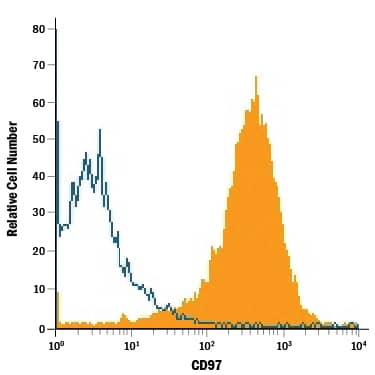Mouse CD97 isoform 1 Antibody
R&D Systems, part of Bio-Techne | Catalog # AF3734


Key Product Details
Species Reactivity
Validated:
Cited:
Applications
Validated:
Cited:
Label
Antibody Source
Product Specifications
Immunogen
Gln24-Arg477
Accession # Q9Z0M6
Specificity
Clonality
Host
Isotype
Scientific Data Images for Mouse CD97 isoform 1 Antibody
Detection of CD97 in Mouse Splenocytes by Flow Cytometry.
Mouse splenocytes were stained with Goat Anti-Mouse CD97 isoform 1 Antigen Affinity-purified Polyclonal Antibody (Catalog # AF3734, filled histogram) or isotype control antibody (Catalog # AB-108-C, open histogram), followed by Phycoerythrin-conjugated Anti-Goat IgG Secondary Antibody (Catalog # F0107).Applications for Mouse CD97 isoform 1 Antibody
CyTOF-ready
Flow Cytometry
Sample: Mouse splenocytes
Western Blot
Sample: Recombinant Mouse CD97 Variant 2 (Catalog # 5494-CD)
Formulation, Preparation, and Storage
Purification
Reconstitution
Formulation
Shipping
Stability & Storage
- 12 months from date of receipt, -20 to -70 °C as supplied.
- 1 month, 2 to 8 °C under sterile conditions after reconstitution.
- 6 months, -20 to -70 °C under sterile conditions after reconstitution.
Background: CD97
CD97 is a member of the LNB-TM7 protein family, which is a subfamily of the G-protein coupled receptor 2 family (1‑3). Molecules in this family have EGF-like modules coupled to class B G protein 7-transmembrane (TM) domains by a glycosylated (mucin) stalk. Three isoforms of CD97 are produced by alternative splicing in mouse. Isoform 1, which is the longest, contains four EGF-like domains. Only the N-terminal EGF-like domain does not bind calcium. In isoform 2, which is described in this insert, does not contain this sequence that corresponds to amino acid (aa) 120‑213 in isoform 1. Compared to isoform 1, isoform 3 lacks a 45 aa sequence between EGF-like domains 2 and 3 (4, 5). Cells known to express CD97 include monocytes, macrophages, T cells, select B cells, dendritic cells and, potentially, vascular and visceral smooth muscle cells (1, 6‑7). CD97 is also differentially expressed on murine hematopoietic stem- and progenitor-cells (7). CD55 (decay accelerating factor), a GPI-linked cell surface molecule with short consensus repeats that regulates complement activation on cell surfaces, chondroiten sulfate and the integrin alpha5 beta (also known as VLA-5) have been identified as cellular ligands for CD97 (7). The composition of the EGF domain region defines the ligand specificity of the different CD97 isoforms (7). The first and second EGF domains interact with CD55, whereas the fourth EGF domain binds chondroitin sulfate (7). The ligand affinity of the CD97 isoforms differs (7). While affinity for CD55 is significantly higher for the smaller isoforms, chondroitin sulfate interacts exclusively with the largest isoforms (7). It has been demonstrated that CD97 is required for neutrophil migration and host defense (8).
References
- McKnight, A.J. and S. Gordon (1998) J Leukoc. Biol. 63:271.
- Stacey, M. et al. (2000) Trends Biochem. Sci. 25:284.
- Stacey, M. et al. (2003) Blood 102:2916.
- Hamann, J. et al. (2000) Int. Immunol. 12:439.
- Qian, Y.-M. et al. (1999) Immunology 98:303.
- Jaspars, L.H. et al. (2001) Tissue Antigens 57:325.
- Van Pel, M. et al. (2008) Haematologica 93:1137.
- Leemans, J.C. et al. (2004) J. Immunol. 172:1125.
Alternate Names
Gene Symbol
UniProt
Additional CD97 Products
Product Documents for Mouse CD97 isoform 1 Antibody
Product Specific Notices for Mouse CD97 isoform 1 Antibody
For research use only